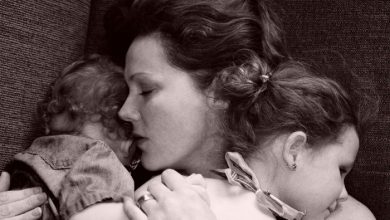
Have you received an email or a phone call from the school?
No parent wants to hear that their child is the problem student. But what if you receive the message that your child is causing problems in class?
In this episode, Anne shares her personal experience with receiving messages from her Type 3 daughter’s teacher. Her story and Carol’s insights can help you navigate challenging conversations and easily find resolution for everyone involved.
This week’s Parenting Practice
Identify an unfavorable scenario that’s causing stress. Put your attention on a more positive outcome that you want to experience. What does it feel like? Really believe that it is available to you. And then, match your language with the outcome you’re picturing. Do some of the techniques Anne mentions in this episode to visualize in more detail.
Transcript of podcast episode
Anne: Things were going good. We got a follow-up email from the teacher. She’s been really great these last two days. Thank you so much for your support. One week goes by and I get another email. Problems again.
Carol: Welcome to “The Child Whisperer Podcast.” I’m your host, Carol Tuttle, author of the best-selling parenting book, “The Child Whisperer.” I’m with my co-host, Anne Tuttle Brown.
Anne: I recently got an email from my daughter’s teacher. My daughter’s a Type 3. She’s 6 years old and in the 1st grade. And it said, “Problems in 1st grade.” And I said, “Oh no, I’m already getting emails. What’s going on?” So, I read through the email and there was some problems in the class. Some gossiping and bullying was happening. And then, I got a follow-up email that was specifically to any of the parents of the children who were kind of instigating the problem.
Carol: So, I have a question. The first email, did it go to everybody in the classroom?
Anne: Yeah.
Carol: Every parent. Not one.
Anne: Yeah. It was a follow-up of what’s been taught in the class and what’s going on, and just, “Can you follow-up with your kids about this? Just want to let you know.”
Carol: Okay. So, the teacher’s asking…
Anne: Handled very professionally.
Carol: …you to just support her, what she’s educating them, and asking for behavioral support with this. You know, “Can you please support me? Blah blah blah.”
Anne: “Just want to let you know what’s going on.”
Carol: So, then the second email…
Anne: And then she said, you know, “There are a couple kids in the class that are kind of instigating this, and Katie happens to be one of them.”
Carol: That just came to you though, right?
Anne: Just to me. And the other parents. I didn’t see who was included in that. But there were a handful of kids in the class that were at the forefront of the problem.
Carol: Okay.
Anne: So, I was like…
Carol: So, I’m curious…
Anne: …first of all…
Carol: …a lot of times, okay, a parent first has an immediate response to that, which is either, “Teacher’s full of it,” or…
Anne: This teacher doesn’t know what they’re talking about.
Carol: Teacher doesn’t know what she’s talking about. Or there’s my child again, being the problem.
Anne: I was the latter. Yeah, definitely like…
Carol: My child, my child… So…
Anne: …my big mouth, big energy kid.
Carol: You went the route of “My kid is the issue.”
Anne: No, I 100% support…I love my daughter’s teacher.
Carol: See, I don’t know. As a Type 3, I might go, “She’s got a lot of nerve.”
Anne: No. The way she handled it was so great.
Carol: “Did the other parents see what she just wrote? Hello.” Okay. So, you…
Anne: And my husband and I are both on the same page. Like, if an adult or another parent of her friend or something comes, like, we’re going to assume that, like…
Carol: Okay. So, did you want to first learn…
Anne: …we need to help correct the daughter.
Carol: …more about, were you like, “I need to learn more before I draw conclusions, and have this then assumption of what this really looks like with this child.”
Anne: True to my Type 2 nature, I kind of went down Worry Lane, and was like, oh no, what does this look like? And okay, I really gotta come down hard. But then, I just…immediately, I shared it with my husband.
Carol: He’s the one that would be more practical and just say, “No, wait, wait a minute. We got to fill in the blank spots here.”
Anne: Yeah, yeah. First of all, and the teacher recognizes this as well. Like, she’s 6 years old. She’s learning what gossiping even is and I loved…the teacher made a point that…
Carol: Did you agree with the teacher’s definition of gossiping and bullying?
Anne: Yeah.
Carol: That’s another point. It’s like, are we all on the same page with…
Anne: Yeah. I think she did a good job…
Carol: …these descriptives?
Anne: …kind of bringing it down. And it was helpful. I went, I shared it with my husband and he was just like, “It’s okay. We’ll just talk to her. We’ll just help her learn and grow” and it wasn’t like we are going to have a serious talk and make her feel like she’s in trouble and scared and never want to do it again. So, I appreciated his just reason and being able to bounce it off. And I emailed the teacher and said, “Thank you for letting me know. I appreciate you wanting to have a really good class environment. We’ll follow up with Katie.” So that night, my husband and I sat down with her and we read her the email and just really…
Carol: How did she respond?
Anne: She got really scared and was like, “But, I’m not the…”
Carol: Teary?
Anne: At first, she was very defensive. And so, we kind of talked to her about that, like, well…
Carol: Which is a Type 3 reaction. No, that would be, rather than…
Anne: She’s like, “Well, someone made me do it,” or “I didn’t do it.” Trying to back track.
Carol: A Type 1 might animate the scenario or what we might consider lie about what’s going on. A Type 2 might just be tearful. Type 3 would be defensive. A Type 4 would be embarrassed probably that, you know, were talked about in an email.
Anne: You’d want to handle that, yeah, very privately. Yeah. So, I read the email to her. We talked about it. She got, first, defensive, then she got scared because her teacher was going to follow-up with her and just have a quick chat with her, and make sure that they’re on the same page. She got really nervous, but we reminded her we’re all here to support you. You’re learning and growing.
Carol: So, you didn’t want to use her own feeling guilty and bad about it as a teaching tool.
Anne: Yeah. We were just like…
Carol: You were trying to counter that. And a lot of parents will do that. They’ll say, “Well, you need to feel guilty about this if you’re really going to change.”
Anne: I was half tempted to go down there, because sometimes I feel like she’s bigger than 6, because she has such a big energy and I’m just like, “You know better than this.” But, like, she’s learning. I got to remember. So, it was coming from a loving place of, okay, what is gossiping? What does it look like in the classroom?
Carol: You didn’t need to use shame as a teaching method, is what I’m wanting to recognize, where a lot of times parents, because we all come from some degree of that, that it’s appropriate for your child to feel shame in order to feel motivated to change, when I don’t agree with that. I think that we all have enough good will in our character to enroll that, to say, “What do I want to contribute? Do I really want to be someone that’s contributing something negative versus contributing something positive?”
Anne: Kids are good kids. They’re going to feel bad about something when they know, like, oh, that wasn’t the right thing to do.
Carol: Was Katie able to…
Anne: And that’s going to be enough.
Carol: Was she able to identify her choices that they were actually exhibiting those behavioral tendencies of gossiping and bullying?
Anne: Yeah. So what happened…
Carol: And she may not have known that’s what it was creating.
Anne: No. And I think the…
Carol: She’s young.
Anne: …teacher did a good job of, “Okay, these are the scenarios.” It was basically, like, she’d have a disagreement with her friend, then she’d tell another friend about it. Or she’d be…so that was considered gossiping.
Carol: Which…how many adults do that?
Anne: Well, that was the big thing. Hello.
Carol: That’s the irony of this to me.
Anne: I come home and I’m like, talking to Tanner about something. And I’m like, by those standards, I’m gossiping right now.
Carol: Exactly.
Anne: And Katie happens to be in the kitchen. That was kind of a big slap in the face for me to be like…and I had to realize, like, oh, I’m gossiping.
Carol: Yeah. I mean, based on what had been described, that talking about an experience…
Anne: A frustration or something.
Carol: …a frustration with someone else, you took to another party. Well then, pretty much the entire adult population is doing that.
Anne: You know, there are proper times to do that, and I think I was out of line having those conversations in front of my children. Whether or not they understand, we all know that kids are very smart and they’ll pick up on things. So, if I need to bring something up with my husband, I’ll do that in private.
Carol: Gossiping, to me is talking about other people’s business that you’re just aware of or an observer of. You’re not involved in. It’s very different than if you’re having an issue with someone and you’re seeking out another person to…
Anne: Right. But if you’re doing it in front of them, which was the case of this scenario, then it’s just people…and they’re just kids, you know. They can be very sensitive. So, it also helped me to understand the teacher’s Type. She’s a Type 1 and I would be like, “That makes sense. She wants to have a really happy classroom.” And so, this is a really high priority for her. And I want to support her in, you know…and that also kind of gave me, like, maybe it’s not as bad as I’m making it out to be.
Carol: Let’s keep this conversation going, Anne. But first, we got a special message for our listeners.
Woman: What’s your mom uniform? Yoga pants? Jeans and a t-shirt? As a mom, you’re busy and wardrobe isn’t high on the priority list. But, do you ever get tired of feeling blah about how you look? Carol Tuttle’s “Dressing Your Truth” program helps you create a personal style that works for you, for your budget, for your family, and for your life. You can look more pulled together in less time. All you need is a little know-how and Carol can show you. Just sign up for a free account at dressingyourtruth.com.
Carol: Okay. So, now you were in a position, what you’re describing here…I want to set this up for people. And that’s why I’m…
Anne: Go ahead.
Carol: …stepping in. And you’ve been taught to look at the bigger scenario, which is, “Why am I creating this, and who’s playing what roles for each other, and why is my child now playing out this part of this story,” as though it was a story you were writing and saying, “Hmm, what’s going on here?” Because ultimately, if it’s showing up in my life, I’m drawing this into my experience. And so is Katie. And so, you started to kind of examine those variables.
Anne: Mm-hmm. So, identifying the Types of my daughter, of myself, of the teacher, knowing tendencies, being accountable and saying, “Where is she learning this behavior? At the home primarily.” And so, like, how can I support her in having uplifting conversations and engaging with friends in a positive way? So, things were going good. We got a follow-up email from the teacher. “She’s been really great these last two days. Thank you so much for your support.” One week goes by and I get another email. Problems again. I’m like, “Oh boy.”
Carol: That’s the subject line?
Anne: I can’t remember. But, basically that’s what the essence was, and it was, you know, this is…
Carol: I just want to point out, I’m seeing a bit of a drama play here. I’m asking you this question specifically is how she’s sort of leading into it to see how much somebody’s presenting this as, “There’s more drama.”
Anne: Yeah. Well, I think the teacher was really supportive. She’s always leading with, “I love Katie. She’s a great asset to her classroom.”
Carol: No, I agree. She’s Type 1.
Anne: “This is happening again.”
Carol: So, she’s going to lead on the positive, which is awesome.
Anne: So, this time I said, “Okay. We’re going in. We’re having a meeting with all three of us.” And this is something I learned from The Child Whisperer Podcast, of the examples of, like, you got to show up and show your seriousness, not by getting louder or more mad, but by your actions. And like, a meeting with her mom and her dad and her teacher is going to show that we mean business, right?
Carol: And it means too…
Anne: That we’re taking this seriously.
Carol: …you’ve all got to talk to work this out.
Anne: Yes. “We’re respecting your teacher. We know what’s going on. You can’t just, like, we’re going to know what’s going on at school even though we’re not there with you.” So, we had a meeting. It was great. The teacher was supportive. Katie got it within the first ten minutes. It went on probably longer than she wanted it to. She was like, “Okay, can I go now?” So, but later, that next day, I was thinking just kind of about the scenario. And I was like, “Man, how long is this going to go on? Is it going to come up again?” Just really hoping that we had cleared this up. And I thought, I just had this visual of, like, Katie being the problem child in the classroom. At least from my perspective, that’s kind of the role she was playing at that moment. And I thought, “You know what?” Just did this little visual in my head of taking her out of that spotlight and just moving her to the background.
Carol: Yeah, because what if the pattern… Okay, this is the bigger story. What if the teacher has a pattern of always having some problem with one of the students or a few of them, that she has to resolve? It’s never quite how she wants it, which is a real possible consideration. And your child just got enrolled in the bigger story.
Anne: And I could definitely be a part of that story with my Type 3/4 daughter whose big personality, can be bossy and in charge. You know what I mean? I could put all these negative labels, and like, yeah, I got that problem child. And so, I was like, “Whoa, whoa, whoa. Let’s reset this story and let’s just move her out, and if that drama needs to play out, someone else can step up and play that role. But, we’re just going to kind of unwind this and untangle and she’s not going to be caught up in this story anymore.” And it was just…
Carol: How did you do that in your visualization? Did you literally see her in the classroom with the spotlight on her?
Anne: Yeah.
Carol: And you take her out.
Anne: I’m naturally a visual learner, so doing these Types of little role plays or visualizations in my mind just kind of helps reset the feeling, that energy.
Carol: right. Because that changes the energy. So if you were to even do that and say…
Anne: And it’s a very clear intention for me.
Carol: You could go up, say, “Katie, we’re going to move out of the spotlight now. You’ve learned what you’ve needed to. You don’t need to play this role anymore.”
Anne: In The Healing Center, you speak to this as, like, an energy sketch. You can even draw it out, if that’s helpful.
Carol: Draw out what you want instead of what’s happening.
Anne: Or if you’d rather write it out, you can write it out in intention. So, it was just easiest. I was just doing my dishes in the kitchen and this came to my mind, and I was like, “Hmm, I’m going to do that.” And it’s just that simple and nothing has come up since.
Carol: Nothing.
Anne: Nothing. And I’m like, great. We took action where appropriate and then I followed it up by kind of cleaning up the energy.
Carol: Yeah. And she maybe…that was a great initial, you know, some early lessons for her…
Anne: Definitely.
Carol: …to establish some behavioral choices.
Anne: Yeah.
Carol: So, it was complete. She didn’t need to be a part of the drama anymore. But, you don’t know if there’s still…do you even have any awareness of…
Anne: I’ve told the teacher to…
Carol: …somebody else get enrolled?
Anne: Oh no, I don’t know.
Carol: Like some other mother getting emails now.
Anne: You know, maybe we just cleared it up for the whole class.
Carol: Could be.
Anne: And I was like, let’s just send sunshine and unicorns to the Type 1 classroom, because she works so hard. They deserve to have a really wonderful, happy classroom environment. So yeah, it’s all just better. And I think just rather than, like, just putting it all on your child or all on you as you failed as a parent, or all on the teacher or the system, you need to take accountability and see all the working parts and pieces and how can they work together, and where is there some disruption and how can it be cleaned up from these conversations that have been had, from your own intentions, and your determination to just help smooth things out and create a more positive experience.
Carol: What you’re describing as far as the power we have to change our experience, I teach really prolifically in my book, Remembering Wholeness, which I think is a really valuable read for parents, because too often, we play in life as though we are powerless and we’re victim to situations. And your story is very evident of the fact that you had choices that you dealt with in the physical experience of it, and the actual relationship quality of it. And then, you had choices to shift the energy and the underlying movement of it to create something different that everybody can benefit from. And we’re that powerful and it’s a big part of my work online is to teach people the choices we have to change the story, so that we’re in a position of thriving. And everybody can be. And your child can grow up without these labels.
What you did essentially, Anne, was to see something different as a possibility, where your daughter was no longer in that experience. You did it with a quick visualization of, “I’m going to take her out of the spotlight. I’m going to now imagine that her classroom’s running smoothly and she’s now being praised and getting support for her positive offerings in the classroom experience.” So, that’s just using that mindfulness and the power of your thoughts and your mind to create a different variable with the intention that that can come to pass, and it has in your experience.
This week’s parenting practice is to identify a scenario that’s unfavorable, causing stress. Well, what if you could change that by just putting your attention on a more positive outcome and really believing that that is available to you. And then, match your language with that. Do some of the techniques Anne has mentioned, draw a little sketch of it. What would it look like. Can you visualize it in your mind in more detail? What about writing it out? “I’m grateful for this experience with my child.” What would the email sound like if it was reporting positive behavioral experiences with your child? What would that subject line say? I’m so grateful for Katie. She makes positive contributions in the class on a regular basis.
Anne: Yeah. You can have a lot of fun getting really detailed with the positive side.
Carol: Yeah, you really can. And to use that power of choice to affect our physical reality to shift, and it will. Anne, as a follow-up, get a copy of Remembering Wholeness and really reinforce this learning that you have these choices, and one of our greatest lessons in the time we live is to truly learn and employ the agency we have to create joyful existences rather than to survive feeling powerless and struggling in life.
Thanks for listening. For more support, go to thechildwhisperer.com where you can purchase the book, subscribe to our weekly parenting practice email, and find a transcription and audio of “The Child Whisperer Podcast.”
Anne: If you’re listening on iTunes, thank you for leaving a review. If you have a parenting question, please send it to [email protected].



